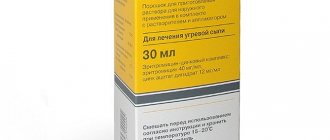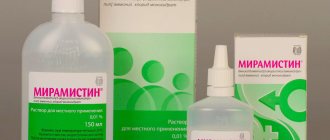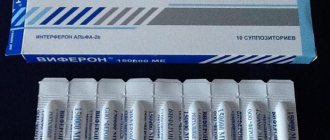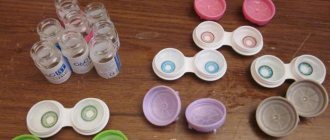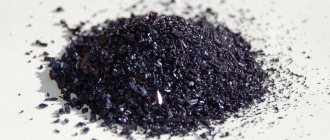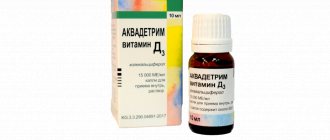To improve vision, it is not necessary to take serious medications; sometimes it is enough to take a course of vitamins and minerals. Drops containing a complex of minerals and vitamins can be used both for the prevention and treatment of various ophthalmological disorders.
The main indications for prescribing vitamins for the eyes are:
- Work that involves eye strain, including computers, papers, books. In this case, the total duration should exceed five hours a day.
- Patients of any age with refractive error (myopia, astigmatism, farsightedness), corneal dystrophy.
- Patients over 40-45 years of age who have developed signs of presbyopia.
- People with cataracts, diabetic retinopathy, glaucoma and other eye diseases.
Types of vitamin drops for eyes
There are various vitamin complexes that need to be instilled into the conjunctival sac, and their effect may vary slightly. For example, drops called Taurine, Taufon, Riboflavin, Vitamin A are excellent for preventing computer syndrome or eye fatigue.
In particular, Riboflavin contains vitamin B2, which has a beneficial effect on the retina and protects it from excessive stress. This vitamin helps improve the conduction of nerve impulses through photoreceptors and optic nerve fibers. In addition, Riboflavin is also suitable for the treatment of inflammatory eye diseases.
Vitamin A, which is contained in various combinations in eye drops, for example in Vita-pos, is used to protect the cornea. Since the condition of this membrane of the eyeball is very important for the normal functioning of the optical system, vitamin A is used to treat dry eye syndrome, dystrophic and inflammatory changes in the cornea.
How to store?
In order to organize proper storage of eye drops, you must refer to the manufacturer's instructions . The pharmacist often warns the buyer about the need to observe the temperature regime for a particular drug. Drops should not be frozen; after a sharp temperature change, the drug may change properties or lose its effect.
| Drug group | Storage temperature |
| Antibacterial (Levomecitin, Tsipromed, Albucid, Floxal, Sofradex) | Not higher than 25 °C |
| Antiviral (Ophthalmoferon, Okoferon, Reaferon) | 2–8 °C |
| Antiallergic (Lecrolin, Cromohexal, Allergodil) | 15–25 °C |
| Vasoconstrictors (Octilia) | Not higher than 25 °C |
| Vasoconstrictors (Visine) | Not higher than 30 °C |
| Vasoconstrictors (Visomitin) | 2–8 °C |
| Moisturizing (Systane Ultra) | no higher than 25° |
As can be seen from the table, the temperature regime for each specific product is individual.
Any drops should be kept in a dark place . It is advisable to minimize temperature changes. For example, it is difficult to maintain the same temperature in a kitchen cabinet throughout the day. When cooking food, the air temperature changes, which can negatively affect the properties of the drug.
In cases where a special mode is required, for example, 2–8°C, drops can only be stored in the refrigerator . Products whose instructions indicate storage conditions at room temperature can also be kept in the refrigerator.
Eye drops can be stored in the refrigerator, on the side door. The main thing is not to allow the drug to freeze .
Vitamin drops for cataracts
Elderly patients, regardless of their vision condition, can use vitamin drops to support the organs of the optical system, restore their functionality, and also improve their overall well-being.
Special drops for elderly patients are usually combined (Taufon, Quinax, Katahrom, Vitofakol, Vita-iodurol) most often aimed at slowing down the process of clouding of the lens (cataract development). These complexes contain vitamins B and C, amino acids, and various antioxidants.
When using such drops, metabolic processes are activated and the natural aging of the lens is slowed down. If, in addition to instilling eye drops, you enrich your diet with foods high in vitamins E and C and omega-3 fatty acids, then the effectiveness of prevention and treatment will increase. In addition, the use of vitamin drops is suitable for patients with chronic ophthalmological diseases (for example, glaucoma) and eyeball trauma.
If you regularly take tablets or capsules with vitamins and minerals, as well as instill such drops into your eyes, you can restore vision even in old age, slow down the aging process and improve performance.
GANFORT eye drops 0.3+5 mg/ml 0.4 ml No. 30
special instructions
Impaired liver and kidney function (the drug has not been sufficiently studied in this category of patients).
In patients with risk factors for macular edema (for example, aphakia, pseudophakia, rupture of the posterior capsule of the lens, as well as intraocular surgery, retinal vein occlusion, inflammatory eye diseases and diabetic retinopathy).
In patients with active intraocular inflammation (eg, uveitis), as inflammation may increase. In patients with mild to moderate chronic obstructive pulmonary disease (COPD), and only in cases where the expected benefit outweighs the possible risk.
In patients with first degree atrioveitricular block due to a negative effect on intracardiac conduction time.
In patients with corneal diseases, since it can induce dry eye syndrome.
In patients with diabetes mellitus (unstable course) and impaired glucose tolerance, since the beta-blocker timolol, which is part of the drug Ganfort®, can mask the signs of hypoglycemia.
Just like other ophthalmic drugs, Ganfort® can penetrate into the systemic circulation. Due to the presence of timolol, a beta-adrenergic component, various types of adverse reactions (cardiovascular and respiratory) may be observed, as with the use of systemic beta blockers. The incidence of adverse reactions with local administration of the drug is lower than with systemic use.
Cardiovascular system Symptoms of heart failure must be compensated before starting to use the drug Ganfort®. Regular monitoring of the condition of patients with severe heart failure and determination of heart rate is necessary. Beta-blockers can mask the symptoms of hypoglycemia, hyperthyroidism and cause worsening of Prinzmetal's angina, severe peripheral and central vascular disorders, as well as arterial hypotension.
Patients with severe peripheral circulatory disorders (eg, severe forms of Raynaud's disease or Raynaud's syndrome) should use the drug with caution.
Respiratory system: When using timolol, there have been reports of side effects from the respiratory system, including deaths due to bronchospasm in patients with bronchial asthma, and also less commonly from heart failure.
Other beta blockers Timolol may affect intraocular pressure or enhance the effect of systemic beta blockers in patients already receiving a systemic beta blocker. Close monitoring of such patients is recommended. Also, the use of two local beta-blockers is not recommended.
Anaphylactic reactions In patients with a history of atonic manifestations and severe anaphylactic reactions to various allergens, doses of epipephrine (adrenaline), which are usually used to relieve anaphylactic reactions, in the lobby the use of beta-blockers may be ineffective. Choroidal detachment Choroidal detachment has been reported with the use of therapy that reduces the flow of intraocular fluid (eg, timolol, acetazolamide) after filtration surgery.
Surgical anesthesia Ophthalmic drugs with a P-blocking effect can suppress the systemic effects (3-agonists, for example, adrenaline. The anesthesiologist must be warned if the patient is using timolol.
Liver In patients with mild liver disease or initially elevated levels of the liver enzymes alapinaminotransferase (AJIT), aspartate aminotransferase (AST) and/or total bilirubin, bimatoprost had no effect on liver function over a study period of more than 24 months. There are no data on adverse reactions due to the effect of timolol on liver function.
Organ of vision Before starting treatment, patients should be informed about the possible growth of eyelashes, increased pigmentation of the skin of the eyelids and pigmentation of the iris, since these side effects were established during studies of bimatoprost and the drug Ganfort. Some changes may be permanent, and may be accompanied by differences between eyes if the drug is installed in only one eye. After discontinuation of the drug Ganfort®, pigmentation of the iris may remain permanent. After 12 months of treatment with Ganfort®, the incidence of iris pigmentation was noted in 0.2% of patients. And after 12 months of treatment with only bimatoprost in the form of eye drops 1.5%, a further increase in the frequency of this effect was not observed during therapy lasting 3 years. Increased pigmentation of the iris is due to increased production of melanocytes, and not simply an increase in their number.
The duration of development of the effect of increased pigmentation of the iris is unknown. The change in color of the iris observed with the use of bimatoprost may not be pronounced over a period of several months to several years. The use of the drug does not affect nevi or pigment deposits on the iris of the eye. Periorbital pigmentation has been reported to be reversible in some patients. A change in refraction is possible (due to the abolition of therapy with mystical means in some cases).
Skin Hair growth is possible on those areas of the skin where the drug was accidentally applied. It is important to use the drug Ganfort strictly in accordance with the instructions for medical use and not to allow the drug Ganfort® to come into contact with the skin. Excipients
The excipient benzalkonium chloride, which is part of the drug Ganfort®, can cause irritation of the mucous membrane of the eyes and discoloration of soft contact lenses. Contact lenses must be removed before administering the drug; they can be put on 15 minutes after installation.
Benzalkonium chloride may cause acute keratitis and/or toxic corneal ulcer. In this regard, it is necessary to monitor the patient’s condition during frequent or prolonged treatment with Ganfort® in persons with dry eye syndrome and changes in the cornea.
After opening the bottle, the possibility of microbial contamination of its contents cannot be ruled out, which can lead to inflammatory eye lesions. The shelf life of the drug after first opening the bottle is 28 days. After the specified time has expired, the bottle should be discarded, even if the solution is not completely used. It is recommended to write down the date the bottle was opened on the cardboard package of the medicinal product. Special instructions Just like other ophthalmic drugs, Ganfort® can penetrate into the systemic circulation and must be compensated before using Ganfort®. Regular monitoring of the condition of insufficiency and determination of the frequency of contractions is necessary.
When using timolol, there have been reports of side effects from the cardiovascular system and respiratory organs, including deaths due to bronchospasm in patients with bronchial asthma, and also less commonly from heart failure.
Beta-blockers can mask the symptoms of hypoglycemia, hyperthyroidism and cause worsening of Prinzmetal's angina, severe peripheral and central vascular disorders, as well as arterial hypotension.
In patients with a history of atopic manifestations and severe anaphylactic reactions to various allergens, doses of epinephrine (adrenaline), which are usually used to relieve anaphylactic reactions, may be ineffective against the use of beta-blockers. In patients with mild liver disease or initially elevated liver enzymes alanine aminotransferase (ALT), aspartate aminotransferase (AST) and/or total bilirubin, bimatoprost had no effect on liver function over a study period of more than 24 months.
Before starting treatment, patients should be informed about the possible growth of eyelashes, increased pigmentation of the skin of the eyelids and pigmentation of the iris, since these side effects were established during studies of bimatoprost and Ganfort®. Some changes may be permanent, and may be accompanied by differences between eyes if the drug is instilled in only one eye. After discontinuation of the drug Ganfort®, pigmentation of the iris may remain permanent. After 12 months of treatment with Ganfort®, the incidence of iris pigmentation was noted in treatment only with bimatoprost in the form of eye drops 1.5%; a further increase in the incidence of this effect was not observed during therapy lasting 3 years. Increased pigmentation of the iris is due to increased production of melanocytes, and not simply an increase in their number.
The excipient benzalkonium chloride, which is part of the drug Ganfort®, can cause irritation of the mucous membrane of the eyes and discoloration of soft contact lenses. Contact lenses must be removed before administering the drug; they can be put on 15 minutes after installation. Benzalkonium chloride may cause acute keratitis and/or toxic corneal ulcer. In this regard, it is necessary to monitor the patient’s condition during frequent or prolonged treatment with Ganfort® in persons with dry eye syndrome and changes in the cornea.
After opening the bottle, the possibility of microbial contamination of its contents cannot be ruled out, which can lead to inflammatory eye lesions. The shelf life of the drug after first opening the bottle is 28 days. After the specified time has expired, the bottle should be discarded, even if the solution is not completely used. It is recommended to write down the date the bottle was opened on the cardboard package of the medicinal product.
In patients with inflammatory changes in the eyes, peovascular, inflammatory, closed-angle glaucoma, congenital glaucoma or narrow-angle glaucoma (no data on efficacy and safety studies).
Vitamin drops for children
A child's body grows and develops very quickly, which is why it is so important that young patients receive sufficient amounts of vitamins and minerals throughout their growing years.
Ophthalmological diseases in children are not uncommon, so most parents try to preserve their child’s vision in every possible way. To do this, you can use special eye drops containing active vitamins and mineral components. Among the most common drops for children are Focus-Forte, Lutein-Complex for Children, Strix, Mertilen-Forte, Mirticam, Pikovit, Vitrum Kids.
It should be noted that eye drops can only be used after prior consultation with a doctor.
Like in a pharmacy: we store medications correctly
Alexey Elikhin
general practitioner, cardiologist at Clinical Diagnostic Center
– Different medications require different storage conditions. If they are not followed, the medicine may deteriorate or become not only ineffective, but also dangerous to health. If, for example, it is indicated that the medicine must be stored in a dark place, then failure to comply with this condition may cause chemical reactions, which, in turn, will lead to a change in the structure of the medicine and, as a consequence, the effect of the drug. Learn more about different storage modes.
Temperature
- Most medications are stored at room temperature – up to +25 °C.
- If the instructions indicate that the medicine should be stored in a cool place, this means that the temperature should not exceed 15 °C. Such drugs are kept in the refrigerator: it is better at the back wall, and not on the door, because temperature changes occur on the door.
Lighting
If the instructions say “store in a dark place,” this means that chemical reactions may occur under the influence of ultraviolet rays, as a result of which the medicine may lose effectiveness or even cause poisoning. The best place to store such medications is a cabinet with opaque doors or a dark container.
Humidity
If the instructions say “store in a dry place,” then the humidity should not exceed 60%. Most often, this recommendation applies to powders and other dry forms, gelatin capsules and herbs. Keeping medications in the bathroom is not a good idea. In most cases, it is impossible to maintain a stable temperature in such a room, and there is always high humidity.
How to store opened medications?
Often, the shelf life of open liquid dosage forms differs from closed ones. Eye drops are stored for one month after opening. And, for example, cough syrup - 1 year if opened and 5 years before opening. This information is indicated in the instructions for medications in the “Shelf life” column. If you open a liquid medicine, write the date and new expiration date clearly on the bottle directly.
Half a tablet or ampoule should not be stored for longer than 12–24 hours unless otherwise stated in the instructions.
Medicinal herbs
If stored improperly, plant materials can become dry or damp. As a result, its active substances will undergo destruction. Herbal mixtures can absorb dust, foreign odors or harmful substances. Beneficial biologically active components can be destroyed when exposed to sunlight.
The shelf life of medicinal herbs is usually quite long, but they need to be stored in a dry and cool room, out of sunlight. It is important that the container in which the herbs are stored is ventilated: this way they will not become damp. Optimal humidity is no more than 60%.
It is recommended to store herbs in paper, cardboard or fabric bags separately from other medicines, as they absorb moisture, vapors, and odors of what is nearby. Herbs that a family member is allergic to should be stored separately from everything else, as well as from food.
Medicines in aerosols
Aerosols and sprays must be stored in original packaging, during the indicated shelf life of the medicinal product, in a place protected from light at a temperature of 8 to 15 ° C, away from flammable drugs and substances. Detailed storage conditions and shelf life of medicines in the form of aerosols are indicated on the packaging and in the instructions. When storing and transporting them, it is important:
- Do not heat the cylinder.
- Avoid mechanical damage to the cylinder.
All this can cause the cylinder to explode.
Liquid forms of medicines
Any liquid dosage form may evaporate, so bottles should be tightly closed. Even with the lid tightly closed, iodine evaporates and can stain nearby objects, and some dry forms of medicines and herbs can absorb it. Alcohol solutions evaporate actively when the packaging is poorly closed.
How to organize your first aid kit
Medicines should be stored out of the reach of children and animals. It is best to store medications in their original packaging - it protects the contents from sunlight and mechanical damage, and also contains the name (usually in large font), so it is convenient to find the drug in the medicine cabinet. You must keep the instructions for use. It indicates the temperature and light conditions for storing a particular medicine, as well as rules for administration and contraindications.
Unfortunately, very often packaging and instructions are lost. To save information you can:
- The expiration date should be duplicated on the blister itself or individual packaging of the medicine.
- Buy a first aid kit with sections. You can take a special container for storing medications with sectors, and use each sector for a separate drug (for example, store medications for headaches in one sector, and for diarrhea in another).
- Separately on bottles with liquid dosage forms (drops, syrups, solutions, etc.) write the shelf life after opening the package.
It is advisable to have several containers for medicines at home:
- For those drugs that are stored in a cool place, that is, in the refrigerator.
- For medications stored at room temperature.
Is it possible to take medications that have expired?
Elena Ladonkina
Ph.D., general practitioner, clinic “K+31 Petrovskie Vorota”
– By taking expired medicine once, we do not put our health at serious risk. This is more true for patients taking many different medications or constant therapy for life-saving reasons, taking medications according to a saturating regimen. The effect of an expired drug can be leveled out until it completely disappears, taking into account the use of other medications.
Open alcohol-based aerosols quickly lose their effectiveness due to the decomposition of the base and the addition of bacteria from the environment. The same applies to ointments. Iodine, brilliant green, hydrogen peroxide from our first aid kit with an expired expiration date will not harm your body, but they will not help either.
If you accidentally take an expired medicine, the same measures are recommended as in case of poisoning of the body: gastric lavage - if a short time has passed after taking it (up to two hours). If more than two hours have passed, you need to take enterosorbents, for example activated carbon, at the rate of 1 tablet per 10 kg of body weight.
Follow the news, subscribe
mail.
When quoting this material, active link to the source
required.
